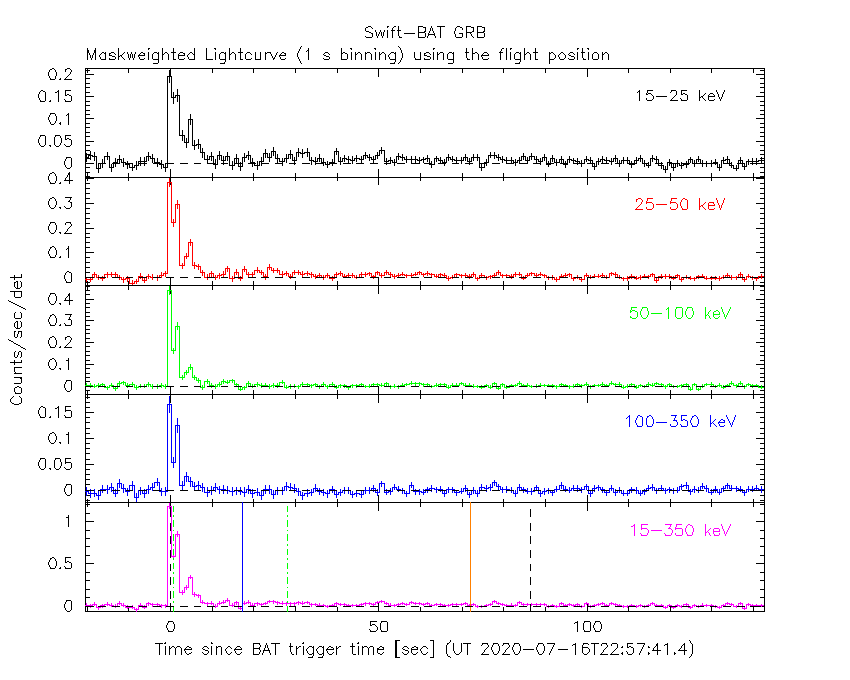
T.N. Ukwatta (LANL) and J.D. Gropp (PSU) for the Swift team
At 22:57:41 UT, the Swift Burst Alert Telescope (BAT) triggered and located GRB 200716C (trigger=982707) (Ukwatta et al. GCN Circ. 28124). Swift slewed immediately to the burst. At the time of the trigger, the initial BAT position was 71° from the Sun (5.3 hours East) and 110° from the 15%-illuminated Moon. Table 1 contains the best reported positions from Swift, and the latest XRT position can be viewed at http://www.swift.ac.uk/xrt_positions.
Ukwatta et al. (GCN Circ. 28124) reported the detection with UVOT of an optical afterglow. Lipunov et al. (GCN Circ. 28125) reported the position from MASTER for the optical afterglow of this GRB. Table 2 is a summary of GCN Circulars about this GRB from observatories other than Swift.
Standard analysis products for this burst are available at https://gcn.gsfc.nasa.gov/swift_gnd_ana.html.
As reported by Barthelmy et al. (GCN Circ. 28136),
the BAT ground-calculated position is RA, Dec = 196.011, 29.636 deg which is RA(J2000) = 1
The mask-weighted light curve (Figure 1) shows two prominent peaks, first at ~T+0.1 s and the second at ~T+2.1.
Significant activity is still visible until ~T+90 s.
The time-averaged spectrum from T-0.42 to T+112.63 s is best fit by a simple power-law model.
The power law index of the time-averaged spectrum is1.65 ± 0.09.
The fluence in the 15-150 keV band is 3.6 ± 0.2 x 1
The results of the batgrbproduct analysis are available at https://gcn.gsfc.nasa.gov/notices_s/982707/BA/.
Analysis of the initial XRT data was reported by Gropp et al. (GCN Circ. 28129). We have analysed 17 ks of XRT data for GRB 200716C, from 86 s to 109.3 ks after the BAT trigger. The data comprise 578 s in Windowed Timing (WT) mode with the remainder in Photon Counting (PC) mode. The enhanced XRT position for this burst was given by Goad et al. (GCN Circ. 28128).
The late-time light curve (Figure 2) (from T0+4.3 ks) can be modelled with a power-law decay with a decay index of α=1.60 ± 0.07.
A spectrum formed from the WT mode data can be fitted with an absorbed power-law with a photon spectral index of 1.56 ± 0.03. The best-fitting absorption column is 5.8 (+1.0, -0.9) x 1
A summary of the PC-mode spectrum is thus:
Total column: 1.1 (+2.1, -0.0) x 1
Galactic foreground: 1.1 x 1
Excess significance: <1.6 σ
Photon index: 1.49 (+0.11, -0.05)
The results of the XRT team automatic analysis are available at http://www.swift.ac.uk/xrt_products/00982707.
UVOT results are not available.

Figure 1. The BAT
mask-weighted light curve in the four individual and total
energy bands. The units are counts

Figure 2. The XRT light curve.
Any data from a crosshatched region are not included in the fit.
| RA (J2000) | Dec (J2000) | Error | Note | Reference |
|---|---|---|---|---|
| 1 |
+29°38'40.6" | 0.75" | UVOT-initial | Ukwatta et al. GCN Circ. 28124 |
| 1 |
+29°38'38.7" | 1.4" | XRT-final | UKSSDC |
| 1 |
+29°38'38.6" | 1.5" | XRT-enhanced | Goad et al. GCN Circ. 28128 |
| 1 |
+29°38'08.4" | 1.0' | BAT-refined | Barthelmy et al. GCN Circ. 28136 |
| Band | Authors | GCN Circ. | Subject | Observatory | Notes |
|---|---|---|---|---|---|
| Optical | Lipunov et al. | 28122 | Swift GRB200716.96: Global MASTER-Net observations report |
MASTER | |
| Optical | Lipunov et al. | 28125 | Swift GRB200716C: Global MASTER-Net OT detection |
MASTER | detection |
| Optical | Hu et al. | 28126 | BOOTES-1 optical afterglow detection | BOOTES-1 | detection |
| Optical | Kumar et al. | 28138 | Optical observations from HCT | Himalayan Chandra Telescope | |
| Optical | Gokuldass et al. | 28146 | VIRT optical detection. | Virgin Island Robotic Telescope | detection |
| Optical | Jelinek et al. | 28149 | FRAM-ORM afterglow detection | FRAM | detection |
| Optical | Pozanenko et al. | 28151 | CrAO, Terskol, Assy-Turgen optical observations |
CrAO | detection |
| Optical | Kann et al. | 28152 | CAHA optical observation // Anomalous light curve behavior? |
CAHA | light curve |
| Optical | Belkin et al. | 28154 | Kitab optical observations | detection | |
| Gamma-ray | Fermi | 28123 | Fermi GBM Final Real-time Localization | Fermi GBM | |
| Gamma-ray | Ohno et al. | 28130 | Fermi-LAT detection | Fermi LAT | |
| Gamma-ray | Ursi et al. | 28133 | AGILE/MCAL detection | AGILE | |
| Gamma-ray | Veres and Meegan | 28135 | Fermi GBM detection | Fermi GBM | Fluence=9.57±0.25x1 (7 |
| Gamma-ray | Torii et al. | 28139 | CALET Gamma-Ray Burst Monitor detection | CALET | |
| Gamma-ray | Xue et al. | 28145 | Insight-HXMT/HE detection | Insight-HXMT | |
| Gamma-ray | Frederiks et al. | 28147 | Konus-Wind observation | Konus-Wind | Fluence=1.2±0.2x1 |
| Gamma-ray | Frederiks et al. | 28148 | Konus-Wind observation of GRB 200716C: correction to GCN Circ. 28147 |
Konus-Wind | Fluence=1.2±0.2x1 |
| Other | D’Avanzo | 28132 | possible host galaxy from the SDSS |
July 24, 2020